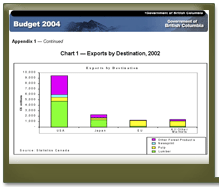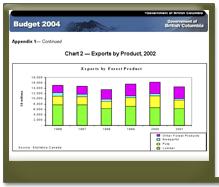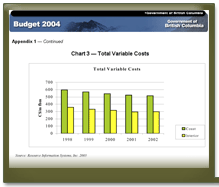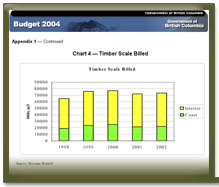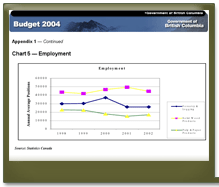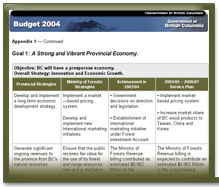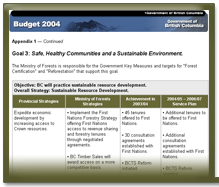 |
|
Appendix 1. Strategic ContextVision, Mission and ValuesVision: Healthy Productive ForestsThe province of British Columbia is renowned for its rich and diverse forest and range resources, more than 90 per cent of which are publicly owned. These resources are a major source of environmental, economic and social benefits, contributing to a high standard of living for individuals and communities across British Columbia. Healthy, productive forests are the cornerstones from which all other forest benefits are possible, including continuous generation of substantial revenue to the Crown. The Forest Service, as the agency responsible for protecting and managing these resources, will focus on ensuring that the health and productivity of the province's forest and range resources are maintained now and in the future. Healthy forests include a diversity of ecosystems that support a full range of forest products, businesses and other opportunities. Mission: Protect and manage our public forests for the sustained benefit of all British Columbians.Since its establishment in 1912, the Forest Service has been mandated to protect and manage the public's forest and range resources. We have recently adopted the motto "Stewards of Our Forests" to reflect this mandate. Other roles have come and gone, but the stewardship role continues to be the foundation of our organization and is reflected in our mission statement. The key responsibilities for the Forest Service in undertaking this mission in the future are:
We will carry out this mandate in co-operation with our other public and private sector partners. To fulfil this mission, the establishment of clear policies and scientifically-based standards to protect the province's forest and range resources are required to ensure a full range of benefits are available from these resources on a sustainable basis. The Forest Service will continue to monitor and enforce standards for the forest and range practices carried out by licensees. At the same time, we will implement pricing and selling policies aimed at making the province's forest sector more competitive in global markets, and ensuring the Crown receives fair value for the use of its forest and range resources. Values:
Ethics:
Planning ContextIntroductionUncertainty and rapid change continue to be pervasive features of the forest sector's global environment. The forest sector is undergoing fundamental change, with the movement to more market-based tenure and pricing systems leading the way. This year we also saw summer wildfires grab headlines, with catastrophic consequences for two British Columbia communities. As we plan for 2004/2005, issues will arise on how the ministry positions itself to deal with such uncertainties. Moreover, current issues will not lie dormant as forest stewardship, the impact of policy reform and access to US markets, and the First Nations growing role in the forest sector continue to dominate the forest policy agenda. Forest StewardshipThe ministry is faced with numerous challenges in managing the large public land based forest resource. The ministry's Service Plan is intended to address the changing nature of the resource as well as related social priorities, devolution of certain management functions to licensees, and collaboration among government agencies. Over the past three years, the province experienced drought conditions that culminated in an extraordinary fire risk and extreme fire behaviour in 2003. The total economic impacts to the province will be measured in hundreds of millions of dollars. The response involved over 10,000 people from emergency response agencies across British Columbia with significant support from other provinces and the federal government. Fire crews and equipment responded from communities all over British Columbia to help affected areas. Forestry personnel were augmented by additional staff and the Canadian military to fight the wildfires. As well, many volunteers and community agencies worked to provide help to evacuees and to those that lost their homes and livelihood. The province has initiated a review of its response to interface fires in 2003. This review is examining how the province worked to mitigate, plan for, and respond to this type of fire threat. It will provide government with recommendations on what went well and what the government should consider to improve its planning and response. The review will be completed by February 15, 2004 and presented to the Office of the Premier. The pertinent recommendations will be implemented in time for the 2004 fire season. Table 1 — 2003 Wildfires in Context
Perhaps the most notable concern related to the forest resource itself is the damage being caused by the unprecedented epidemic of mountain pine beetle in the North-Central Interior. New data on the mountain pine beetle show they are expanding throughout the entire interior of the province. This year alone, the beetle has infested more forest than was burned during the summer's wildfires. The pine beetle epidemic has grown by 40 per cent since last year and is now threatening 160 million cubic metres of timber, 2.5 times more than the allowable annual cut (AAC). This insect epidemic currently covers an area of about 9 million hectares stretching from Smithers to Cranbrook and is expected to continue to expand exponentially. The actual area infested is approximately 4.0 million hectares within this larger area. The outbreak is expected to continue to expand unless climatic conditions cause a collapse. The main areas of the beetle epidemic are essentially impossible to control by man-made means; a large-scale program is underway to harvest infested timber before it becomes economically worthless. Limited control work is also being conducted on the edges of the outbreak and in areas where efforts can be expected to have some success. While mountain pine beetle is the issue for the interior, changing forest management approaches is the focus on the coast. Coastal silvicultural systems are changing to more closely mimic natural ecosystem dynamics. The shift towards variable retention logging has introduced a need to understand the impacts on timber supply, water quality, and a wide variety of flora and fauna. Full implementation of the Forest and Range Practices Act will be a major objective in 2004/05. Designed to ensure that British Columbia achieves high quality forest management and environmental standards in a streamlined regulatory environment, the Act will take effect January 2004, with a transition period to December 31, 2005, when the Forest Practices Code and the new Act will both be in effect. As the new Act replaces previous forest practices code there will be a greater emphasis on defining acceptable results on the ground. Licensees and individual professionals will also enjoy greater autonomy in deciding how best to achieve specified results. Revitalizing the Forest Sector In the Spring, the Legislature passed a series of bills changing the fundamental way the forest sector is managed. The changes focused the reallocation of timber rights and the implemention of market-based policy reform. The purposes of these changes are to create the framework for a competitive, dynamic forest industry and to maximize the contribution of the forest sector to British Columbians' standard of living. The tenure reallocation requires major licensees to return 20 per cent of the AAC held under replaceable tenures to the Crown after the first 200,000 m3. About half of this AAC will then be redistributed to open up opportunities for woodlots, community forests and First Nations. The other half will be sold at auction to increase the portion of timber going through open markets and to assist in setting up stumpage rates. Reallocating timber rights will:
Softwood Lumber Dispute Up-date
First Nations Accommodation and Consultation The uncertainty associated with unresolved First Nations land claims continues to affect the provincial forest sector. Recent court decisions have reinforced the importance of consultation with and accommodation of First Nations' interests. It will take time and experience to adequately sort out the roles and responsibilities of government, industry and First Nations in this regard. Part of the Forestry Revitalization Plan is to set a portion of the AAC that is reallocated from existing tenures for First Nations who enter into accommodation agreements with the province. These agreements may be negotiated where there are unresolved aboriginal rights and title issues, as an interim step towards a comprehensive treaty or other form of settlement. Ultimately, about eight per cent of the total provincial AAC will be made available for such arrangements. There has been significant progress in this regard. On October 15, 2003, an agreement between the British Columbia government and Gitga'at First Nation was struck, where the First Nations community received $1.57 million over the next five years and the right to apply for licences to cut 290,000 cubic metres of old-growth forest in the Hartley Bay area. It is hoped that the arrangement will be an impetus for similar agreements with an alliance of eight First Nations on the British Columbia coast, an endeavor often referred to as the Turning Point Initiative. Economic IndicatorsExports British Columbia's forest-based industries produce an array of wood products, but are dominated by the production of lumber, pulp and paper, and panels which are subsequently sold into world markets. The ministry's market-based policy reform is focused on supporting a globally competitive forest industry while ensuring that the public receives fair value for its resource.
Total British Columbia forest exports dropped from $16.3 billion in 2000 to $14.6 billion in 2001, and down to $14.4 billion in 2002. Reduced pulp shipments and softwood lumber accounted for much of the change. Forest products maintain 49.5 per cent of total provincial exports and approximately 8 per cent of world exports of forest products. The primary market for British Columbia products is the US, which imported 64.4 per cent of British Columbia's total provincial forest product exports in 2002. Japan is the second-largest market, accounting for approximately 15.5 per cent of exports 2.
Prices The forest sector's reliance on exports means that world prices are an important determinant of the health of the sector as a whole. The price of spruce-pine-fir (SPF) softwood lumber 2x4s, the key product of the interior lumber industry, increased from an average of US$235/thousand board feet (mfbm) in 2002 to a monthly average of US$314/mfbm as of August 2003. The price for hemlock baby squares, a key product for the Coastal industry, decreased from a 2002 average of US$597/mfbm to a monthly average of US$530/mfbm (as of August 2003), a decrease of 12.64 per cent. Japanese demand remains below 1990s levels and is likely to remain so given Japanese economic performance and shifts in product demand. Market demand for northern bleached softwood kraft (NBSK) pulp weakened markedly in both 2001 and 2002. In 2002 NBSK pulp averaged US$463/tonne, down by 32 per cent from the 2000 average of US$681/tonne3. However, 2003 saw a surge in price of up to US$513/tonne, an increase of 10.8 per cent.
Average newsprint prices for 2002 were US$468/tonne, a drop of 20 per cent from the 2001 rate of US$588/tonne. There was some recovery in 2003 as prices slightly rose 5.3 per cent to US$493/tonne. Production Costs In addition to world prices, production costs are important to the provincial forest sector. For a cyclical, competitive, mature industry to be successful in the global marketplace, variable costs must be kept low. In 2002, variable costs — or costs that vary directly with output — were comparatively stable. The variable cost category includes costs of harvesting, labour and supply. For a variety of reasons, including the diversity of wood types and terrain, the British Columbia Coast has significantly higher lumber production costs overall than the Interior. High production costs, changing markets, and environmental pressures continue to exert significant restructuring pressures on the coast.
British Columbia Harvest Levels British Columbia total harvest levels (Crown and private land), as measured by timber scale billed, rose slightly from 72 million m3 in 2002 to 73.38 million m3 in 2003. Results from the first eight months indicate that harvest levels will increase slightly again for the year as a whole.
Employment Employment statistics show a general weakness in the forest sector. The aggregate employment levels of the industry dropped to 87,300 in 2002, a decrease of 3,300 jobs from 2001. The pulp and paper product category showed an increase of 1,700 jobs. The largest fall occurred in the solid wood products category with a decrease of 4,875 jobs. There are approximately 1,900 fewer jobs in August 2003 compared to the same month in the previous year.
Long Term OutlookGlobal Supply While demand-side issues have been the center of attention for the past few years, any economic scan of the provincial forest sector is incomplete without an examination of timber supply. World timber supply is not expected to be a constraint on global forest product production in the foreseeable future. It is expected that the availability of wood fibre will improve significantly over the next 20 to 25 years, as the commercial production of timber becomes increasingly concentrated on managed forests and plantations. While timber inventories in global "native" forests are expected to decline moderately, "non-native" plantation inventories will more than compensate for the loss. Both economic and environmental factors are responsible for reshaping the world's fibre supply. From a production prospective, non-native plantations are generally more productive than their native counterparts, and many countries have actively encouraged investment in this type of forest resource. Simultaneously, there has been increasing international pressure for the conservation of "native" forests due to concerns about deforestation and forest degradation. Indeed, globally, British Columbia's forest resource is unique. For example, British Columbia's remaining old-growth coastal rainforest represents approximately 25 per cent of the remaining coastal temperate rainforest worldwide. By 2025, some experts predict that fibre from "non-native" plantation inventories will represent one-third of the operable growing stock and supply more than half of global wood fibre needs. In terms of wood supply, this means that Asia, Central America, South America, Australia and New Zealand will become increasingly important wood-fibre suppliers. From a British Columbia perspective, this likely implies increased competition in world forest product markets and increased pressure for the conservation of increasingly rare forest types. But perhaps a more looming issue is that in some regions of the world, there appears to be a growing surplus of forests, and a general oversupply of timber and logs relative to demand. Temperate harvest increases in Russia and Eastern Europe, coupled with emerging plantation-pine surpluses in the southern hemisphere, may be emerging as the spoilers in world markets. In North America, up to 94 per cent of the timber increment is harvested, yet the EU average is 64 per cent, and Russia — a vastly developing timber supplier — is only harvesting 16 per cent of its net annual incremental timber growth. The implications are obvious: the potential of an oversupplied market means downward pressure on timber and wood products prices. Sustainability Third party certification of forest practices continues to be seen as a means of ensuring sustainable resource management and excellence in forest stewardship. It is expected that, over time, certification will become more of a prerequisite for access to global forest product markets. Virtually every major British Columbia forest company has either achieved or is pursuing third-party certification. Issues on the Horizon Besides the current external forces influencing the British Columbia forest sector, other issues in the foreseeable future will surely affect the supply and demand of British Columbia wood products. Some of these issues include the following:
The British Columbia forest sector will continue to face the challenges associated with a dynamic and ever-changing global environment. Only a sector that is outward looking, globally competitive, environmentally responsible, and locally accountable will be able to succeed. The ministry's ongoing task is to ensure that an appropriate policy, regulatory and legislative framework is in place to support these objectives. Highlights of Strategic Shifts and Changes from the Previous PlanThe ministry is on track to achieving the key components outlined in the 2003/04 to 2005/06 Service Plan published last year. Changes from last year, now included in this Plan, are: Strategic shifts
Summary of Changes to Key Outcome Indicators (KOIs) and Corporate Performance Measures (CPMs):The performance measure of the "Per cent of Timber Supply Areas under Defined Forest Area Management" has been deleted from the Service Plan due to a change in the direction of the initiative, and the delay in enacting the related legislation. A new measure is expected to be introduced during 2004/05 to track DFAM implementation. Two previous Forest Investment corporate performance measures will now be tracked by the agencies responsible for the activities, independent of the funding source. Outcomes associated with the "volume gain of timber available for harvest in 65 years from FI land-based and tree improvement activities" are now tracked by MOF under the Stewardship of Forest Resources Core Business. The outcomes associated with the "percentage increase in provincial inventory information" belong to the Ministry of Sustainable Resource Management. Six performance measures included under the goal of being an effective and responsive forest manager have been deleted from this Service Plan beginning in 2004/05. Two of these, "per cent of corporate performance measure targets achieved" and "per cent of expenditure targets achieved," will still be reported annually in summary format. The following four will now be tracked internally only by the ministry:
New Indicators and Measures for 2004/05:
Consistency with Government's Strategic PlanThe draft 2004/05 to 2006/07 Government Strategic Plan has been used to align the Ministry of Forests strategies, achievements and plans under the government goals, objectives and strategies.
|
|||||||||||||||||||||||||||||||||||||||||||||||||||||||||||||||||||||||||||||||||||||||||||||||||||||||||||||||||||||||||||||||||||||||||||||||||
|
||||||||||||||||||||||||||||||||||||||||||||||||||||||||||||||||||||||||||||||||||||||||||||||||||||||||||||||||||||||||||||||||||||||||||||||||||
